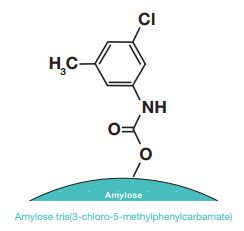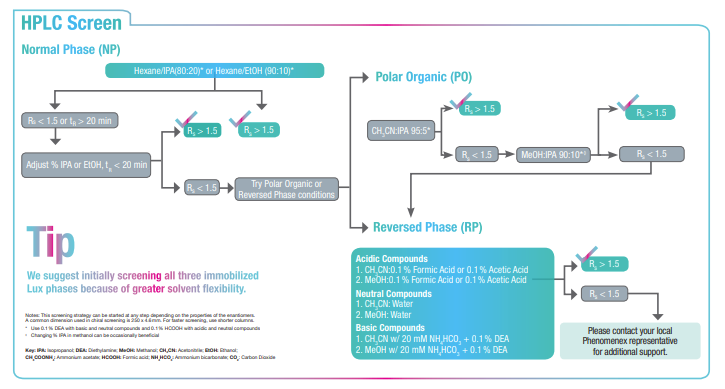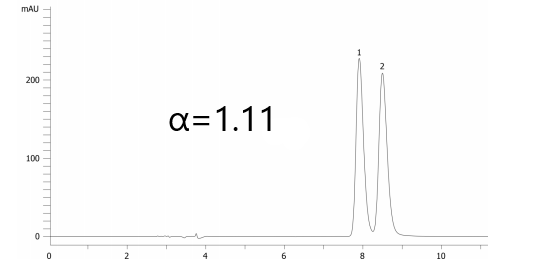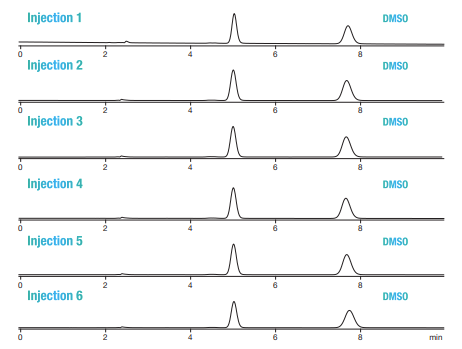Polysaccharide chiral stationary phases are widely used in enantiomeric separations. There are numerous benefits to using a polysaccharide stationary phase which include the wide chiral recognition they offer stemming from the numerous chiral sites found in the sugar molecule used to form the stationary phase. To these sugar molecules polar aromatic groups are bound to enhance the selectivity. This enhancement is which offers greater chiral recognition over chiral stationary phases of a different nature
Polysaccharide phases offer good flexibility in terms of the type of mobile phase you can work with and allow the user to use normal phase, polar organic, reversed phase and SFC modes, all with a single chiral column. The stationary phases are strong and robust and offer good loadability as they are silica based.
The polysaccharide based chiral selector can come coated or immobilized onto the silica particle and this can affect selectivity, either directly through a change in interaction with the phase or indirectly through the use of different solvents available to you when you use an immobilized phase in place of a coated phase.


Most polysaccharide-based chiral stationary phases are coated, and this means the stationary phase is not covalently bonded to the underlying silica. A number of chiral selectors in recent years have been immobilized to the silica particle which means they are covalently linked and infer greater stability in a wider range of more aggressive solvents. The ability to use an expanded range of solvents has increased the selectivity options of these chiral selectors and below we give some tips on how to maximise chiral selectivity using immobilised polysaccharide chiral stationary phases.
With an immobilised phase you have a wider range of organic solvents at your disposal during method development, this can allow you to resolve notoriously problematic enantiomers by working with stronger organic solvents.
Here baseline resolution of Ornidazole is achieved on the immobilised Cellulose-5 phase by introducing MtBe into the mobile phase and this combination shows greater resolution compared to the coated Cellulose-1 phase.

| Chiral Separation of Ornidazole on Lux 5 µ i-Celluslose-5 | |||
|---|---|---|---|
| Column | Lux 5µm i-Cellulose-5, LC Column, ea. | ||
| Dimensions | 250 x 4.6 mm ID | ||
| Order No. | 00G-4756-E0 | ||
| Elution Type | Isocratic | ||
| Eluent A | 0.1% Ethylamine in MtBE | ||
| Flow Rate | 1 mL/min | ||
| Column Temperature | ambient | ||
| Detection | UV-Vis Abs.-Variable Wave. (UV) @ 254 nm (ambient) | ||

| Ornidazole on Lux 5 µm Cellulose-1 in NP | |||
|---|---|---|---|
| Column | Lux 5µm Cellulose-1, LC Column, ea. | ||
| Dimensions | 250 x 4.6 mm ID | ||
| Order No. | 00G-4459-E0 | ||
| Elution Type | Isocratic | ||
| Eluent A | Hexane / etOH (80:20) DEA (0.1%) | ||
| Flow Rate | 1 mL/min | ||
| Column Temperature | ambient | ||
| Detection | UV-Vis Abs.-Variable Wave. (UV) @ 220 nm (ambient) | ||
Injecting using strong organic solvents:
Many applications require the use of a strong organic solvent for injection – with a coated phase these can lead to stationary phase dissolution and loss of selectivity. With an immobilised phase no damage is done and selectivity is maintained throughout the lifetime of the column. Here we see no change in resolution when an immobilised phase is used even with a DMSO injection solvent.

| Conditions for all columns | |||
|---|---|---|---|
| Column | Lux 5µm i-Cellulose-5 | ||
| Dimensions | 250 x 4.6 mm ID | ||
| Order No. | 00G-4756-E0 | ||
| Mobile Phase | Methanol/DEA (100:0.1) | ||
| Flow Rate | 1.5 mL/min | ||
| Detection | UV @ 280 nm | ||
| Temperature | 27 C | ||
| Sample | Laudanosine | ||
| Dilution Solvent | Dimethyl Sulfoxide (DMSO) | ||
In summary with polysaccharide chiral stationary phases you have a wide chiral recognition and vast permutations of mobile phase systems and selectivity’s at your disposal. This can help ensure good enantiomeric resolution for almost all chiral molecules when a methodical and thorough screening process is done.
